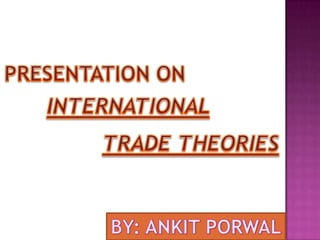
International Trade Theories
- 2. International Trade Theories INTERNATIONAL TRADE THEORIES MERCANTILISM THEORY OF ABSOLUTE ADVANTAGE THEORY OF COMPARATIVE ADVANTAGE
- 3. Mercantilism Thomas mun and others propagated this theory in U.K. between 16th &17th century. Gold and silver were used as medium of exchange between countries. Gold and silver were the mainstays of national wealth. Country should always maintain trade surplus by exporting more than imported. Government should intervene to achieve trade surplus by imposing tariffs and quotas on imports and subsidizing the exports.
- 4. Mercantilism This is viewed as Zero Sum Game. theory is not suitable in the long run. Decay of gold standard reduced the validity of this theory.
- 5. Adam smith propounded this theory in 1776. He believed that trade is a positive sum game. Free trade enables a country to produce a variety of goods and services. This theory is based on the principle of division of labour. The countries which produce goods more efficiently than the other countries has an absolute advantage. Country should never produce goods that it can buy at a lower rate from other countries.
- 6. Assumptions Trade is between two countries Only two commodities are traded Free trade exists between the countries The only element of cost of production is labor.
- 7. Country Sugar Jute India 10 20 Bangladesh 40 10 Production and consumption without trade. Country Sugar Jute India 10 5 Bangladesh 2.5 10 Note: The resources are divided equally i.e.,100 resources for each.
- 8. Production with specialization Country Sugar Jute India 20 0 Bangladesh 0 20 Consumption after 6 tons of both are traded between them. Country Sugar Jute India 14 6 Bangladesh 6 14 Increase in consumption due to trade Country Sugar Jute India 4 1 Bangladesh 3.5 4
- 9. Output per one day of labour country Pens Tape recorders Japan 20 6 India 60 2 Production and consumption without trade. Output per one day of labour country Pens Tape recorders Japan 10 3 India 30 1 Note: The time is divided equally for manufacturing i.e., 50%
- 10. Production with specialization Output per one day of labor Japan India Pens 0 60 Tape recorders 6 0 Production and consumption with trade. Output per one day of labor Japan India Pens 30 30 Tape recorders 3 3 Note: terms of trade 10 pens = 1 tape recorder. Increase in consumption due to trade Output per one day of labor Japan India Pens 20 30 Tape recorders 3 2
- 11. Y ------- Japan PP(CD) …….. Indian PP(EF) Without trade: Japan-A India-B With specialization: Japan-C India- F 60 F P e n s 50 40 india B 30 20 10 0 D japan 1 A 2 E C 3 4 5 Tape recorders 6 X
- 12. Both the countries can have more quantities of both the products. Increases the standard of living due to increased trade. Inefficiency in producing certain products in some countries can be avoided. Global efficiency and effectiveness can be increased by trading. Global labour productivity and other resources productivity can be maximised.
- 13. No absolute cost advantage. Country size. Fixed cost of resources. Transport cost. Assumed away the effects of trade on income distribution within the country. Absolute advantage for many products.
- 14. This theory is propounded by David Ricardo in 1817. This theory stress that comparative advantage arises from differences in productivity.
- 15. Each country has a fixed stock of resources. The only element of cost of production is labour. Production is the subject to the law of constant returns. All the units of labor homogeneous There are no trade barriers. Trade takes place only between two products and two countries. There is no cost of transportation. There is a perfect competition
- 16. Country Sugar Jute India 10 13.33 Bangladesh 40 20 Production and consumption without trade. Country Sugar Jute India 10 7.5 Bangladesh 2.5 5 Note: India allots 100 resources for sugar and 100resources for jute.
- 17. Production with specialization Country Sugar Jute India 15 3.75 Bangladesh 0 10 NOTE: India allots 150 resources for sugar & 50 resources for jute Consumption after trading 4 tons Country Sugar Jute India 11 7.75 Bangladesh 4 6 Increase in consumption due to trade Country Sugar Jute India 1 0.25 Bangladesh 1.5 1
- 18. y 20 S A E 15 U G A R ------- PP of B’desh(5/10) -------PP of India (15/20) Without trade: Bangladesh: F(2.5-5) India-G(10-7.5) With specialization Bangladesh: D(0-10) India: E(15-3.75) G 10 C 5 2.5 F D 0 3.75 5 7.5 10 JUTE B 15 X 20
- 19. Efficient allocation of global resources. Maximization of global production at the least possible cost. Parity among world markets. Demand for resources and products will be optimized.
- 20. Only two countries Transportation costs Only two products Nothing about exchange rates Assumed away differences in prices of resources Mobility Services
